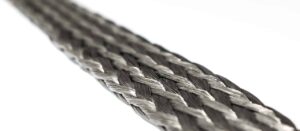Discover our 5 families of copper braid solutions and flexible copper connectors
TESORAX supports you in your projects
All our braids, bare and tinned copper flat braids, ground copper braids, copper cables, connectors and flexible cables, and Litz wires are manufactured in our factory in Spain. 100 years of expertise at the service of manufacturers. From identifying the need for connection to installation, including design and manufacture, we support and advise manufacturers in all stages of the implementation of the technical solution in special cables and connections. We consider each product as a project, responding to a very specific need.
Why use braiding?
The braiding of the cable allows a better mechanical resistance, and has the big advantage of maintaining the flexibility of the cable, indispensable in mobile and flexible applications. 
In particular, the intertwined threads make it possible to absorb the forces which are practiced by bending, without giving in and without breaking. The copper braid offer as well better mechanical resistance if that is the desired goal.
Why use copper wires?
In the case of applications requiring perfect protection of the integrity of the signal, we will use copper wires, bare or tinned, which are perfect electrical conductors. In addition, compared to bare copper, tinned copper offers better resistance to oxidation. Its choice may thus depend on the installation conditions of the braid and its environment. Depending on the end use, need and specifications, copper wires will be braided or stranded. We work with wires of different diameters, from 0.04mm in diameter and up to 0.25mm in diameter (up to 5mm for Litz wires). The technical data displayed for each product is indicative, as we can manufacture any variant. Depending on the need, we can indeed make sections from the smallest (0.75mm²) to the largest (1200mm²).
Particularity of the Litz Wires
Under certain operating conditions, especially in a high frequency situation, the use of "simple" copper wires is not sufficient. Indeed, a physical phenomenon called "skin effect" appears and causes significant losses in the current transfer, which can have disastrous consequences in the performance of the application concerned. To treat it, it is then necessary to use what are called enamelled copper wires, that is to say covered with an email. Properly sized according to the customer's specifications (thread diameter, type of enamel, number of strands, etc.) these threads will be assembled together to form what are then called Litz threads.
Click here for more informations.
What is the difference between braiding and stranding?
While braiding is an interlacing of strands, stranding is the act of bringing together and "twisting" wires, strands, in order to form a cable.
We define a stranding by:
- step direction ( Diagram a. )
- The step in S: The strand passes from the top to the left down to the right of the driver
- Z step: The strand passes from the top to the right down to the left of the driver
- step length ( Diagram b. )

- le diamètre de câble
 the cable length
the cable length
- the section







 the cable length
the cable length